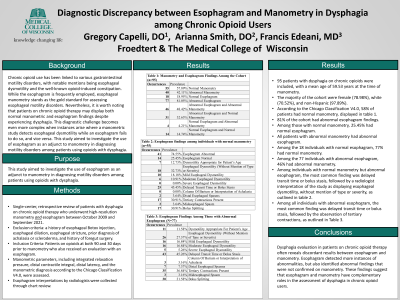Monday Poster Session
Category: Esophagus
P1842 - Diagnostic Discrepancy Between Esophagram and Manometry in Dysphagia Among Chronic Opioid Users
Monday, October 23, 2023
10:30 AM - 4:15 PM PT
Location: Exhibit Hall

Has Audio

Arianna Smith, DO
Medical College of Wisconsin
Milwaukee, WI
Presenting Author(s)
Gregory Capelli, DO, Arianna Smith, DO
Medical College of Wisconsin, Milwaukee, WI
Introduction: Chronic opioid use has been associated with gastrointestinal motility disorders, including esophageal dysmotility and opioid-induced constipation. Esophageal manometry is considered the gold standard for evaluating esophageal motility disorders; however, normal findings are often observed in patients with dysphagia on chronic opioid therapy. This study aimed to investigate the use of esophagram as an adjunct to manometry in diagnosing motility disorders among these patients.
Methods: A retrospective review was conducted on patients with dysphagia on chronic opioid therapy who underwent high-resolution manometry and esophagram between October 2009 and September 2021. Exclusion criteria included a history of esophageal Botox injection, esophageal dilation, esophageal stricture, prior diagnosis of achalasia or scleroderma, and history of foregut surgery. Patients on opioids at both 90 and 30 days prior to manometry were included. Manometric parameters, including integrated relaxation pressure, distal contractile integral, distal latency, and the manometric diagnosis according to the Chicago Classification V4.0, were assessed. Esophagram interpretations by radiologists were collected through chart review.
Results: Ninety-five patients with dysphagia on chronic opioids were included, with a mean age of 59.53 years at the time of manometry. The majority were female (78.98%), white (70.52%), and non-Hispanic (97.89%). According to the Chicago Classification V4.0, 58% of patients had normal manometry, as shown in Table 1. Additionally, 81% of the cohort had abnormal esophagram findings. Among those with normal manometry, 25.45% had normal esophagram. All patients with abnormal manometry had abnormal esophagram. Among the 18 individuals with normal esophagram, 77% had normal manometry. Among the 77 individuals with abnormal esophagram, 46% had abnormal manometry.
Discussion: Dysphagia evaluation in patients on chronic opioid therapy often reveals discordant results between esophagram and manometry. Esophagram detected more instances of abnormalities, but also identified abnormal findings that were not confirmed on manometry. These findings suggest that esophagram and manometry have complementary roles in the assessment of dysphagia in chronic opioid users.
Disclosures:
Gregory Capelli, DO, Arianna Smith, DO. P1842 - Diagnostic Discrepancy Between Esophagram and Manometry in Dysphagia Among Chronic Opioid Users, ACG 2023 Annual Scientific Meeting Abstracts. Vancouver, BC, Canada: American College of Gastroenterology.
Medical College of Wisconsin, Milwaukee, WI
Introduction: Chronic opioid use has been associated with gastrointestinal motility disorders, including esophageal dysmotility and opioid-induced constipation. Esophageal manometry is considered the gold standard for evaluating esophageal motility disorders; however, normal findings are often observed in patients with dysphagia on chronic opioid therapy. This study aimed to investigate the use of esophagram as an adjunct to manometry in diagnosing motility disorders among these patients.
Methods: A retrospective review was conducted on patients with dysphagia on chronic opioid therapy who underwent high-resolution manometry and esophagram between October 2009 and September 2021. Exclusion criteria included a history of esophageal Botox injection, esophageal dilation, esophageal stricture, prior diagnosis of achalasia or scleroderma, and history of foregut surgery. Patients on opioids at both 90 and 30 days prior to manometry were included. Manometric parameters, including integrated relaxation pressure, distal contractile integral, distal latency, and the manometric diagnosis according to the Chicago Classification V4.0, were assessed. Esophagram interpretations by radiologists were collected through chart review.
Results: Ninety-five patients with dysphagia on chronic opioids were included, with a mean age of 59.53 years at the time of manometry. The majority were female (78.98%), white (70.52%), and non-Hispanic (97.89%). According to the Chicago Classification V4.0, 58% of patients had normal manometry, as shown in Table 1. Additionally, 81% of the cohort had abnormal esophagram findings. Among those with normal manometry, 25.45% had normal esophagram. All patients with abnormal manometry had abnormal esophagram. Among the 18 individuals with normal esophagram, 77% had normal manometry. Among the 77 individuals with abnormal esophagram, 46% had abnormal manometry.
Discussion: Dysphagia evaluation in patients on chronic opioid therapy often reveals discordant results between esophagram and manometry. Esophagram detected more instances of abnormalities, but also identified abnormal findings that were not confirmed on manometry. These findings suggest that esophagram and manometry have complementary roles in the assessment of dysphagia in chronic opioid users.
Disclosures:
Gregory Capelli indicated no relevant financial relationships.
Arianna Smith indicated no relevant financial relationships.
Gregory Capelli, DO, Arianna Smith, DO. P1842 - Diagnostic Discrepancy Between Esophagram and Manometry in Dysphagia Among Chronic Opioid Users, ACG 2023 Annual Scientific Meeting Abstracts. Vancouver, BC, Canada: American College of Gastroenterology.
